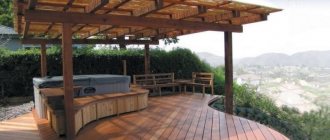Plants for beginner gardeners
Thanks to its properties that provide water reserves, plants can survive in conditions of insufficient moisture, as well as under prolonged exposure to ultraviolet rays. Therefore, this plant is so popular among gardeners. Succulents do not require careful and careful care, as well as extensive experience in breeding. Even a novice gardener can cope with growing this plant.
Succulents are a fairly common and popular plant in the world. There are about 800 varieties of this plant. However, the most popular among gardeners are noted, such as:
- Cacti: a favorite plant of gardeners in many countries around the world. A distinctive feature of this plant is that it is easy to care for. Also, medicinal properties are present in cacti. It has long been known that cacti can absorb toxins and radiation without harming their vital functions. This factor is one of the main reasons for the popularity of the plant; Read more about popular types of cacti
- Aloe: everyone knows the Aloe plant, thanks to its components, on the basis of which many products are created in the cosmetic industry; Read more about popular homemade Aloe species
- Kalanchoe: This plant is often used for medicinal purposes and many species are famous for their colorful blooms. Read more about popular domestic species of Kalanchoe
Features of propagation and transplantation of succulents
Let's start with the first one - the tops of twigs (cuttings) or fleshy leaves are used as planting material. It is not necessary to send the cuttings into a container with water - let the cuts dry slightly (1-2 days), and then simply stick them into damp soil.
As for the leaves, it is necessary to act differently - first, they are completely separated from the stem so that no organic residues are observed on the cuttings. Afterwards, simply place the leaf on moist, loose soil in a well-lit place. The succulent leaf will sprout roots on its own and anchor itself in the ground - there is no need to bury it in the ground.
Succulents produce an abundant number of shoots: feel free to separate the children from the mother plant and plant them in moist soil. In such conditions they take root on their own.
The period allotted for manipulating the transplantation (propagation) of plants in our latitudes falls on April - August (the most favorable months are April and May), when solar activity is high. However, sedums readily take root in the fall - the faded stems are cut to the base and stuck into moist soil. In spring, most of them germinate and produce new individuals.
Varieties of succulents according to the process of moisture accumulation
It is worth noting that all succulents are divided into two main groups, which differ in the process of moisture accumulation.
- Leaf succulents: moisture in this species accumulates in thick leaves, which have a unique waxy shell in their structure, which allows them to accumulate liquid and retain it for a significant period of time.
- Stem succulents: they differ from the leaf type in that liquid accumulation occurs in the stem. Thanks to the root system, which retains moisture on the soil surface, it becomes possible to retain liquid in the plant stem.
Succulent plants, which belong to the stem variety, have the ability to accumulate and retain moisture in the thickened part of the stem. The leaves are usually small in size and distinguished by the presence of spines. If we talk about succulents that belong to the leaf variety, then moisture accumulates thanks to the foliage, which has a fleshy and thick structure.
Leaf succulent – Sedum / Stem – Stapelia
It is noted that succulents, regardless of the variety, easily adapt to the following conditions:
- Arid climate;
- Low amount of moisture and precipitation;
- Unbalanced fluid distribution;
- In case of high background radiation levels;
- The influence of ultraviolet radiation;
- Adapts perfectly to dry air;
- The influence of temperature fluctuations;
- The influence of clay or rocky soil.
What are succulents
The name comes from the Latin word succulents, meaning “juicy”, “fleshy”. This term refers to plants that can store water in their own tissues. Typically, these crops live in arid areas.
Known varieties of succulents belong to families that often have nothing in common. Thus, some species are classified as bromeliads, others as aroids, and others as grapes.
This is interesting: the first attempts to grow succulents at home were made in Europe back in the 16th century.
In total, the group includes more than 2000 plants from 100 genera. All cultures spread throughout the world from South and Central America. A considerable part of them are cacti. This word comes from Greece - this is how any thorny plants are called there.
The mechanism by which succulents conserve moisture varies. Stem plants, for example, store water only in the trunk. As a rule, they do not have leaves at all (they have transformed into thorns), or they do have them, but they are very small. Almost all cacti fall into this category.
Other succulents store fluid in their leaves. This group includes:
- haworthia;
- aloe;
- Kalanchoe;
- lithops;
- Echeveria.
In our country, in warm areas with sandy soil, representatives of the Crassulaceae grow:
- young;
- sedum
Looking at the various succulents in the photo, you can notice a feature common to all types. Their structure ensures the creation of mechanisms aimed at maximizing water conservation. So, to save moisture:
- some plants have reduced the number of respiratory stomata;
- others have reduced the length of the stem;
- some turned leaves into thorns, etc.
In some species, during drought, the above-ground parts completely die off; they are restored only when the unfavorable period ends.
Succulent plants have learned to defend themselves from animals - many members of the group have become poisonous. Thorns protect well from enemies, as well as camouflage - there are cacti that look like stones, or even like a mouth open in a predatory grin.
Popular families
Succulent plants, regardless of species, are divided into many families. However, in horticulture, the main families are recognized, such as:
- Cactus family (Astrophytum, Opuntia, Mammillaria);
- Family of swallowtails (Caralluma, Stapelia, Guernia);
- Asphodel family (Aloe, Gasteria, Haworthia);
- Crassula family (Kalanchoe, Sedum, Crassula);
- Euphorbiaceae family (Poinsettia, Codiaum, Pedilanthus);
- Family Aizoonaceae (Lithops, Conophytum, Fenestraria).
Useful video
There are a large number of indoor species. Plants differ in shape, color and structure; they are united only by climatic conditions and endurance. They are widely used for medical purposes and are also involved in the production of cosmetic products. Also, do not forget about the ability of this plant to decorate any interior. An indoor succulent flower can live in a house with temperature fluctuations, which does not have a negative impact on its development.
Popular home succulents
Echeveria
In nature, there are about 170 species of this plant. Echeveria hybrids are also grown at home - these are Pachiveria and Graptoveria. It has smooth succulent leaves with a whitish, grayish or bluish coating. There are also species with velvet leaves (Echeveria alba). Outwardly it is similar to Molodilo, but unlike it does not tolerate cold well. Common domestic species: Agave, White-haired, Shiny, Humpbacked, Derenberga, Multi-stemmed. Read more about popular types and care
Echeveria
Young (Sempervivum) - Stone rose, hare cabbage
In natural conditions, there are more than forty species of this plant. There are a variety of leaf colors and shapes. This species is grown both at home and in the garden. When grown together, different species are capable of cross-pollination, thus producing unusual hybrids of this plant. The most commonly grown plants at home are: roofing, offspring, cobweb, Russian young. Read more about popular types and care of Stone Rose
Rejuvenated
Haworthia
It has dark green fleshy leaves, sometimes with convex white growths. It grows as a small bush. It blooms with inconspicuous white flowers. There are varieties such as: rigid-leaved (pearl, retracted, Reinwardt), herbaceous (cobweb, reticulate, herbaceous) and window (scaphoid, blunt, stubby). The most commonly grown species at home are: Cooper's, striped, drawn, winding, navicular, sticky, retusa and others.
Read more about popular types and care of Haworthia
Haworthia
Aloe spinous (Aloe aristata)
This species is often confused with Haworthia due to their similar appearance. This plant has thick, arched leaves with a rough surface and white spots. At the end of the leaf there is a characteristic white thread. It usually blooms in late spring with red and orange tubular flowers collected in a raceme (Haworthia has white flowers). Read more about popular homemade Aloe species
Aloe spinosa
Kalanchoe blossfeldiana
Decorative blooming appearance. It has smooth, rich green, round leaves with dissected edges. In flower shops you can find a variety of colors of inflorescences. Hybrid species with stuffed and terry corollas (Kalanchoe Kalandiva) are also sold. Read more about popular domestic species of Kalanchoe
Kalanchoe Blossfeld
These plants can be suitable for absolutely anyone, even those with small children at home, since they do not cause an allergic reaction and are not difficult to care for.
Stapelia
Outwardly it resembles a cactus, but is a succulent. Has no thorns. The surface is soft, like velvet. The stems are triangular with jagged edges. It blooms with unusual large bright flowers - stars, burgundy, yellow or spotted in color, which is why it is loved by gardeners. She is not fussy about care. Popular domestic species - Stapelia variegated, large-flowered, star-shaped, ferruginous. Read more about popular types and care
Stapelia
Gasteria
Succulent with fleshy tongue-shaped leaves. Most often it has a variegated color. The leaves are covered with a white coating in the form of spots or stripes. People call it the language of a lawyer. Blooms with small bells. Popular domestic species are Gasteria warty, keeled, spotted. Read more about care and popular types
Gasteria
Agave
It is not fussy to care for, but requires good lighting throughout the year, because... The plant is native to Mexico. The leaves are collected in dense rosettes, some have spines at the ends. It blooms rarely, once every 15-30 years. After which the plant may die. Loves heat and, under suitable conditions, reaches large sizes. Popular domestic species are Agave americana, Queen Victoria, blue, King Ferdinand, filamentous, drawn. Read more about care and popular types
Agave
Ampelous succulents
Plants of ampelous succulents, as a rule, are distinguished by a rich cluster of leaves. The branches grow and bend down towards the ground. Hanging pots are usually used for growing. Representatives of this species are unpretentious, but require more attention and care compared to other succulents.
There are basic requirements for caring for hanging succulents:
- Light balance. Ampelous succulents do not like high concentrations of sunlight, so it is recommended to shade them and avoid direct sunlight. However, it is worth considering that the further the plant is placed from the light, the paler the pattern on the leaves will be.
- Excessive moisture. The plant does not like high moisture, it can be destructive. Therefore, it is necessary to provide a good drainage system and adhere to a moderate watering regime.
- Spraying the leaves of the plant.
Inexperienced lovers of hanging succulents should know that from the period of flowering of the bud, the plant requires maximum rest. Any fertilizers are excluded. For efficient and timely growth and flowering, you need to carefully monitor the location of each side of the flower relative to the sun's rays. Balancing sunbathing on both sides will allow the flower to look as impressive as possible. It is also worth knowing about the periods of replanting a hanging plant. So, the plant needs to be replanted every year in the spring. Widely known types of hanging succulents:
Sedum - Sedum
There are more than six hundred species of this plant. Sedum is grown both at home and in the garden. It has a variety of leaf shapes and colors. Some sedums are ampelous. Common domestic types of sedum: Morgana, Weinberg, Siebold, variegated, beautiful sedum and others. Read more about popular types and care
sedum
Lampranthus
More than 100 species of this plant are known to grow in natural conditions. The stems can reach up to half a meter in length. Blooms in summer and autumn. The flowers are bright orange or pink. At home, lampranthus are most often grown: deltoid, orange, magnificent and others.
Lampranthus
Anacampseros
Belongs to the Portulakov family. It has a weaving stem with fleshy leaves arranged symmetrically on the shoots. Blooms with pink inflorescences. Loves watering and well-lit rooms. It grows beautifully. Domestic species of Anacampseros: Alstona, paper-like, tomentose, Camptona, lanceolate.
Anacampseros
Ceropegia
Perennial herbaceous hanging succulent. It has a shortened tuberous rhizome. It has small, fleshy, ovoid leaves. The shoots are long, creeping. It has axillary flowers and blooms throughout the year. Common species grown at home are Ceropegia africana, Barclay's, Wood's, Sanderson's, and stapeliiformes. Read more about popular types and care
Ceropegia
Stones succulents
Stone succulents or lithops are gaining great popularity among plants kept in the home. Lithops "Living Stones" are native to the African deserts and are the name given to succulent plants in the form of stones. There are many species and subspecies of these plants. Thanks to the work of breeders, new species of this delightful plant appear every year. Thus, today there are 30 species and 60 subspecies of “living stones”, which have already become popular in many countries of the world. This plant is quite unpretentious. Lithops successfully take root in various conditions.
The peculiarity of plants of this species lies not only in their ambiguous appearance, but also in their structure. Thus, the plant does not have a stem, located on two fused, dense leaves with a small cleft. The crevice serves for the growth of roots and flowers. The differences are also in the varieties of plant color, of which there are quite a lot. There are main types of lithops:
- Marble lithops. They are distinguished by the gray-green color of the leaves with a dark pattern;
- Leslie. Lithops Leslie is distinguished by a speckled brown color, as well as a yellow or white flower with a pleasant aroma;
- Beautiful lithops. They are distinguished by yellow-brown leaves and white flowers.
The plants are unpretentious, but there are special requirements for preserving the vital activity of flowers. It is necessary to keep the plant in a dry room at room temperature, the presence of light is also very important for the growth of the plant. Stone succulents are quite popular not only among gardeners, but also among hobbyists. However, there are also succulents in the form of a tree, which are no less popular among gardeners and lovers of exotic plants and plants.
Read more about popular types of lithops and their care
Lithops
Succulents - tree
Succulents in the form of trees look unusual and impressive. Some of them have even become symbols, for example, a money tree, which you can grow yourself at home, or buy a ready-made plant of suitable size. Like all types of succulents, trees of this species are quite prolific and reproduce under normal conditions. There are two main ways to propagate a succulent tree:
- Using seeds;
- Using cuttings.
(Read more about propagating succulents by seeds and cuttings)
For the full growth and development of a tree, you must follow the basic rules:
- The succulent tree loves the sun's rays. In winter, many gardeners actively use photo lamps, which allow the tree to meet its needs for ultraviolet rays;
- Temperature plays an important role in the formation of wood. An optimal temperature is required, not exceeding 25 degrees in the room.
A succulent tree can live for a long time with optimal and proper care.
Succulents are a fairly extensive type of vegetation, with many species of flowering plants and trees. Plants of this type are famous not only for their exquisite beauty, but also for their adaptation to almost any climatic conditions and easy care. Most often grown at home:
Adenium
This is a small tree or bush. It grows slowly, has a fleshy trunk with a thickening at the bottom (caudex) and branched stems. Flower growers love it for its unusual appearance and beautiful flowering. Adenium juice is poisonous. The following species are grown at home: obssum, mini, multi-flowered, anuk. Read more about popular types and care of Adenium
Adenium
Crassula - Crassula or Money Tree
It is a fairly unpretentious plant, which is why it is very popular. In total there are more than three hundred species. It is believed that peace and prosperity will reign in the house where the fat plant grows. The following types are most often grown at home: oval, clubmoss, tetrahedral. Read more about domestic species of Crassula with names and photos
Crassula
Dorstenia
Plants of this genus are both herbaceous and succulents. Dorsthenia foul-smelling and Dorsthenia antivenom are grown at home. The juice of this plant is poisonous and has an unpleasant odor. Under natural conditions, these tree-like succulents reach sizes up to 5 meters in height.
Dorstenia
Aichryson
A representative of the Crassulaceae family. Popularly called the Tree of Love. A small tree-like bush. The leaves are fleshy, oval and covered with fine hair. The flowers are bright yellow, blooming profusely in dense inflorescences. Read more about domestic species, growing and caring for Aichrizon
Aichrizon
How to care for succulents at home
Succulents are desert dwellers, accustomed to the scorching rays of the sun. The first rule of growing a healthy plant is adequate lighting. The optimal placement option would be south, south-east and south-west windows. If the apartment is oriented north, you will need an additional light source.
Not all types of succulents can withstand direct sunlight. Before purchasing, it is worth studying the characteristics of the specific plant chosen.
Author's advice
Watering directly depends on the characteristics of the variety and the time of year. During the hot period, water is added on average once every 1-2 weeks, focusing on the condition of the soil. The soil should be dry for at least 3 days between waterings. In winter, one watering per month is enough. The main thing is that the roots do not dry out.
Under natural conditions, succulents grow on sandy soils mixed with crushed stone. When replanting, it is worth considering that succulents require loose soil with good breathability. In every gardening store you can purchase a ready-made mixture, which can be supplemented in accordance with the requirements of a particular variety.
Young plants are replanted annually, and adults - after 2-3 years. In addition, they need systematic feeding, which is carried out in the spring and summer. It is enough to apply specialized compounds for succulents once a month. The only thing worth keeping an eye on is the nitrogen content, since its excess will cause rotting of the root system.











